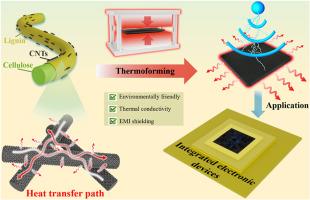Bio-composites with efficient heat dissipation and excellent EMI shielding by constructing bamboo fiber/MWCNT dual network structure
IF 11.6
2区 材料科学
Q1 CHEMISTRY, PHYSICAL
引用次数: 0
Abstract
Traditional electromagnetic shielding materials primarily address electromagnetic interference (EMI) but overlook excessive heat accumulation caused by the miniaturization and high-frequency operation of integrated electronics. This thermal buildup compromises device lifespan, stability, and reliability, restricting their applicability in heat-sensitive applications. In this study, heterogeneous dual-network bio-based composites (BPC/MWCNT) exhibiting high thermal conductivity, EMI shielding effectiveness, and mechanical strength were fabricated via lignin regeneration technology, utilizing lignin as a structural bridge. The BPC/MWCNT biocomposites demonstrate outstanding mechanical properties, achieving tensile and flexural strengths of 53.28 MPa and 60.58 MPa, respectively. This property originates in the melt-regenerated in-situ lignin acting as a green binder under high-temperature/-pressure conditions, forming a robust adhesive interface via interfacial hydrogen bonding, π-π stacking, and mechanical interlocking, thereby reconciling the mutually repulsive properties. Notably, the biocomposite exhibits a thermal conductivity of 1.03 W m−1 K−1, surpassing conventional wood and bamboo materials by a significant margin. This enhanced performance arises from a dense three-dimensional dual-network BPC/MWCNT structure formed through high-temperature compression. Despite the inherently low thermal conductivity of bamboo fibers, the architecture facilitates efficient heat conduction and dissipation at the interface between the highly conductive MWCNT and bamboo fibers. Furthermore, the incorporation of MWCNT improves electrical conductivity and delivers an EMI shielding effectiveness of 73.8 dB. The three-dimensional dual-network architecture achieved via this sustainable strategy offers a viable solution to address simultaneous thermal accumulation and EMI challenges in integrated electronics.

竹纤维/MWCNT双网结构的生物复合材料具有高效散热和良好的电磁干扰屏蔽性能
传统的电磁屏蔽材料主要针对电磁干扰(EMI),而忽略了集成电子器件小型化和高频运行所引起的过多的热量积累。这种热积累损害了器件的使用寿命、稳定性和可靠性,限制了它们在热敏应用中的适用性。在本研究中,利用木质素作为结构桥梁,利用木质素再生技术制备了具有高导热性、EMI屏蔽效果和机械强度的非均相双网络生物基复合材料(BPC/MWCNT)。BPC/MWCNT生物复合材料表现出优异的力学性能,拉伸和弯曲强度分别达到53.28 MPa和60.58 MPa。这种性质源于熔融再生的原位木质素在高温/压力条件下作为绿色粘合剂,通过界面氢键、π-π堆叠和机械联锁形成坚固的粘合界面,从而协调相互排斥的性质。值得注意的是,这种生物复合材料的导热系数为1.03 W m−1 K−1,大大超过了传统的木材和竹子材料。这种增强的性能源于高温压缩形成的致密的三维双网络BPC/MWCNT结构。尽管竹纤维固有的低导热性,但这种结构有助于在高导热MWCNT和竹纤维之间的界面上进行有效的热传导和散热。此外,MWCNT的加入提高了电导率,并提供了73.8 dB的EMI屏蔽效率。通过这种可持续策略实现的三维双网络架构为解决集成电子产品中同时存在的热积累和EMI挑战提供了可行的解决方案。
本文章由计算机程序翻译,如有差异,请以英文原文为准。
求助全文
约1分钟内获得全文
求助全文
来源期刊

Carbon
工程技术-材料科学:综合
CiteScore
20.80
自引率
7.30%
发文量
0
审稿时长
23 days
期刊介绍:
The journal Carbon is an international multidisciplinary forum for communicating scientific advances in the field of carbon materials. It reports new findings related to the formation, structure, properties, behaviors, and technological applications of carbons. Carbons are a broad class of ordered or disordered solid phases composed primarily of elemental carbon, including but not limited to carbon black, carbon fibers and filaments, carbon nanotubes, diamond and diamond-like carbon, fullerenes, glassy carbon, graphite, graphene, graphene-oxide, porous carbons, pyrolytic carbon, and other sp2 and non-sp2 hybridized carbon systems. Carbon is the companion title to the open access journal Carbon Trends. Relevant application areas for carbon materials include biology and medicine, catalysis, electronic, optoelectronic, spintronic, high-frequency, and photonic devices, energy storage and conversion systems, environmental applications and water treatment, smart materials and systems, and structural and thermal applications.
 求助内容:
求助内容: 应助结果提醒方式:
应助结果提醒方式:


